A well-crafted CV is a critical component of a successful job application for any role, and this is especially true for data scientists. A CV is their first opportunity to showcase their skills, experience, and qualifications to a potential employer. As such, it must effectively communicate their value proposition and demonstrate that they have the necessary skills and experience to perform the job at a high level.
Employers are looking for data scientists who can collect, analyze, and interpret complex data to help them make informed decisions. Therefore, a data scientist’s CV must showcase their technical expertise, analytical abilities, and communication skills. It should also demonstrate their experience in using relevant tools and techniques to drive business outcomes, such as improving customer experience, increasing revenue, and reducing costs.
In addition to highlighting technical skills, a CV should also demonstrate their ability to work collaboratively, manage projects effectively, and communicate complex ideas to both technical and non-technical stakeholders. A well-crafted CV will give potential employers a clear sense of a data scientist’s capabilities and make them stand out from other candidates.
In conclusion, a well-crafted CV is an essential component of a successful data scientist job application. It allows job seekers to showcase their skills, experience, and qualifications and demonstrate their potential value to potential employers.
The primary responsibilities of data scientists include the following:
- Extracting large volumes of unstructured and structured data
- Employing advanced statistical and analytical methods
- Preparing data for modeling and processing
- Solving various business-related problems
- Discovering new algorithms that could solve issues or automate specific processes
- Suggesting better alternatives to existing strategies and solutions.
Key Sections of Resume for a Data Scientist
Given below are the key sections:
Choose the best format for a template
The first step to creating a good resume is choosing a format you will follow. As there are several format types, you should select the one that best fits you in terms of industry and years of experience.
Here is more information on each type of format:
- Reverse chronological resume: Reverse chronological resumes are ideal for individuals with plenty of experience working in a specific niche for a while now. Therefore, such resumes mainly focus on the experience section.
- Functional resume: These are better options for less experienced individuals or people who frequently change careers. The focus of these resumes is on the skills of the applicant.
- Hybrid resume: Both experienced and entry-level applicants can use this format because it combines the best aspects of both. They also work great if you have been employed in various industries.
Personal information
This section should include your full name, contact information (email, phone number, and location), and a link to your professional online profile (such as LinkedIn). Make sure that your email address and phone number are professional and appropriate for a job application.
Here are some examples that can help you understand how to structure the personal information section of a data scientist’s CV:
- Name:
Start with your full name at the top of the CV, ideally in a larger font to make it more prominent.
EXAMPLE
John Doe
- Contact information:
Below your name, include your contact information, like your email address, phone number, and location. Make sure that the email address and phone number you provide are professional and appropriate for a job application.
EXAMPLE
John Doe
johndoe@email.com
(555) 123-4567
New York, NY
- Link to your professional online profile:
Including a link to your professional online profile, such as your LinkedIn profile, is an excellent way to provide recruiters and hiring managers with additional information about your skills and experience. Make sure that your LinkedIn profile is up-to-date and aligned with the content in your CV.
EXAMPLE
John Doe
johndoe@email.com
(555) 123-4567
New York, NY
LinkedIn: www.linkedin.com/in/johndoe
By following these examples, you can create a personal information section that provides recruiters and hiring managers with all the necessary information to contact you and learn more about your professional profile.
Include a captivating personal statement
A personal statement is a section in a CV that provides a summary of who you are, what you can offer the employer, and what your career goals are. It is an opportunity for you to introduce yourself to the employer and convince them that you are the best fit for the job. Two main types of personal statements can be included in a CV: the summary statement and the objective statement.
A summary statement is a type of personal statement that focuses on the candidate’s skills and experience, and how they are a good fit for the position they are applying for. It is usually tailored to the specific job posting and provides concrete evidence of the candidate’s qualifications and accomplishments.
In contrast, an objective statement is a type of personal statement that focuses on the candidate’s career goals and objectives, and how the position they are applying for can help them achieve those goals. It is usually more general and not tailored to a specific job posting.
Both types of personal statements can be effective in a CV, but the summary statement is more commonly used and is generally considered more effective in modern job applications. By investing time and effort in crafting an effective personal statement, you can significantly increase your chances of securing an interview and ultimately getting hired.
Highlight your work experience details
This section should list your professional experience, including the job title, company name, dates of employment, and a brief description of your responsibilities and achievements. Make sure to use action verbs and quantify your achievements wherever possible. For example, if you worked on a project that resulted in a significant increase in revenue, mention the percentage increase.
The experience section is undoubtedly the most critical part of your resume, so take the following steps to include the essential information:
- Use clear formatting and list experience chronologically.
- Focus on achievements and quantify the impact.
- Tailor experience to the job and use relevant keywords.
- Keep descriptions brief and avoid jargon.
- Use numbers to quantify achievements wherever possible.
Writing this section as an entry-level candidate
If you are an entry-level candidate, you do not have the previous work experience necessary to create this section and make it impressive. However, you can mention projects, internships, and volunteer work since they all contribute to your experience.
- Include relevant volunteer work: If you have volunteered for a non-profit or contributed to open-source projects related to data science, mention it in the experience section. This can demonstrate your passion for the field and showcase your skills.
- Highlight your projects: If you have worked on any personal projects or coursework related to data science, include them in your experience section. Describe the project and your role, and highlight any achievements or results you obtained.
- Detail your internships: If you have completed any internships related to data science, include them in your experience section. Detail the projects you worked on, the skills you developed, and any outcomes you achieved.
- Emphasize transferable skills: If you have experience in a different field, highlight any transferable skills that are relevant to data science. For example, if you have experience in customer service, highlight your communication skills and ability to work under pressure.
- Quantify your achievements: Even if you don’t have a lot of work experience, try to quantify your achievements wherever possible. For example, if you completed a project that improved data quality, mention how much data was affected and how much the quality improved. By incorporating these tips, an entry-level candidate can create a compelling Experience section that showcases their skills, experience, and achievements in data science.
Explain your education details
This section should list your educational qualifications, including the name of the institution, the degree you earned, and the year of graduation. If you have completed any relevant coursework or research projects, you can include those as well.
Consider adding these pieces of information when talking about your education:
- Your university and name of the degree
- The year of graduation
- Your GPA and final marks
- Details of relevant coursework
- Accomplishments and awards you received
- Other relevant courses and certificates.
Include relevant skills
In this section, you should list all the technical and soft skills that you possess as a data scientist. This should include your proficiency with programming languages like Python, R, SQL, and tools like Tableau and Excel. It should also include your experience with machine learning, data visualization, data cleaning and wrangling, and statistical analysis. Make sure to prioritize the skills that are most relevant to the job you are applying for.
To ensure that this section is well-written:
- Keep the list of skills simple and short
- Include technical and soft skills
- Mention all the skills mentioned in the job description
- Restate the competencies you listed in your career summary.
Since data science is a complex field, you should have all the skills to analyze the available data and turn it into actionable insights. Some of the skills you might want to mention are:
- Big data
- Data mining
- Deep learning
- Machine learning
- Predictive modeling
- Python Programming
- Statistics
- SQL.
Projects
In this section, you can highlight any data science projects you have worked on independently or as part of a team. Make sure to include a brief description of the project, the tools and technologies you used, and the impact that the project had.
This section can be particularly helpful in showcasing your technical skills and problem-solving abilities. Some important tips to remember while writing this section:
- Provide a brief description of each project, including the problem it was intended to solve and any key insights or findings that resulted from your work
- Mention the tools and technologies you used to complete the project, such as Python, SQL, R, or Tableau, to demonstrate your proficiency with relevant data science tools
- Quantify the impact of the project in some way, such as by mentioning improvements in accuracy or increases in revenue
- If you worked on a project as part of a team, provide some context about the team’s goals and your specific role
- Include links to relevant work, such as a GitHub repository or a blog post, to provide additional evidence of your skills and experience
Certifications
If you have completed any relevant certifications, such as a certification in data science or machine learning, list them in this section. Include the name of the certification, the issuing organization, and the date you received it.
EXAMPLEs
- “Certified Data Scientist” from the Data Science Council of America (DASCA), received in May 2020
- “Machine Learning Engineer” certification from Udacity, received in August 2019
- “Data Science Essentials” certificate from IBM, received in January 2018
Listing relevant certifications in your CV can demonstrate to potential employers that you have a strong foundation in key concepts and techniques related to data science and machine learning. It can also show that you are committed to ongoing learning and professional development in your field.
Include Other Sections (Optional)
The other sections that you can include are:
Publications
If you have authored or co-authored any relevant publications, such as research papers or articles related to data science or machine learning, you may want to include a section highlighting these publications.
Awards and honors
If you have received any awards or honors related to your work in data science, you could include a section listing these accolades.
Professional memberships
If you are a member of any professional organizations related to data science or machine learning, you could list these memberships in a separate section of your resume.
Languages
If you speak multiple languages, you could include a section listing your language proficiency levels.
Interests
In some cases, it may be appropriate to include a brief section about your interests or hobbies. This can help to humanize your resume and give potential employers a sense of who you are as a person, beyond your professional qualifications. However, it is important to keep this section brief and relevant to the job you are applying for.
Data Scientist Resume Examples & Templates
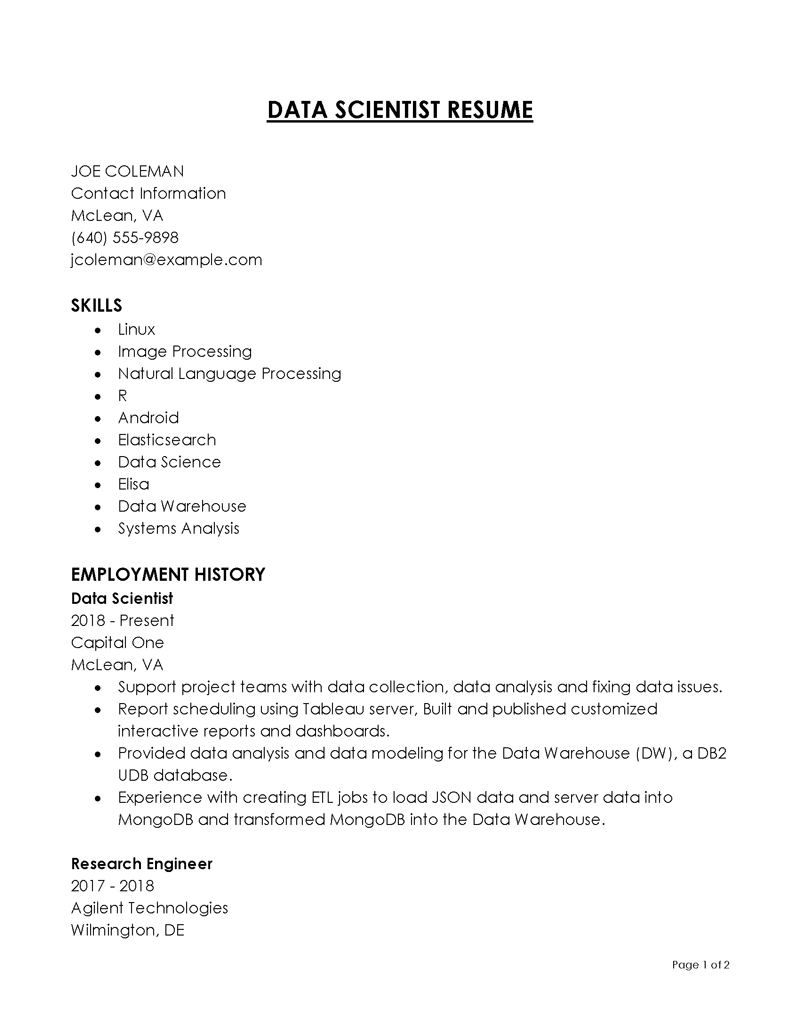
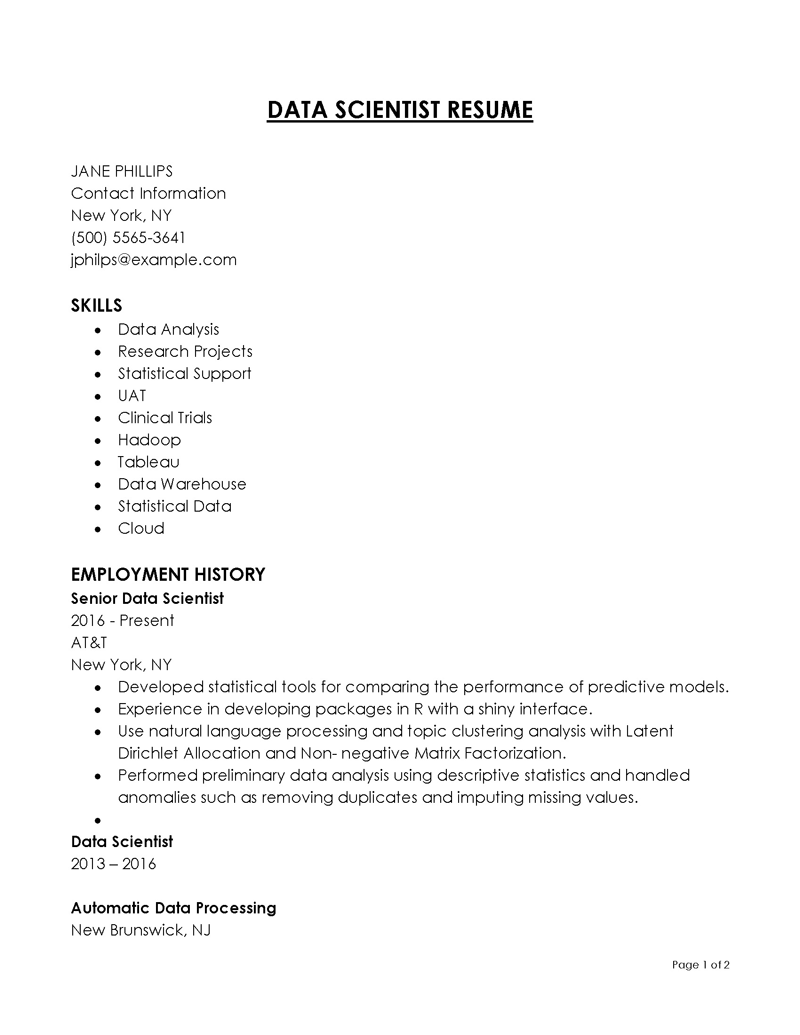
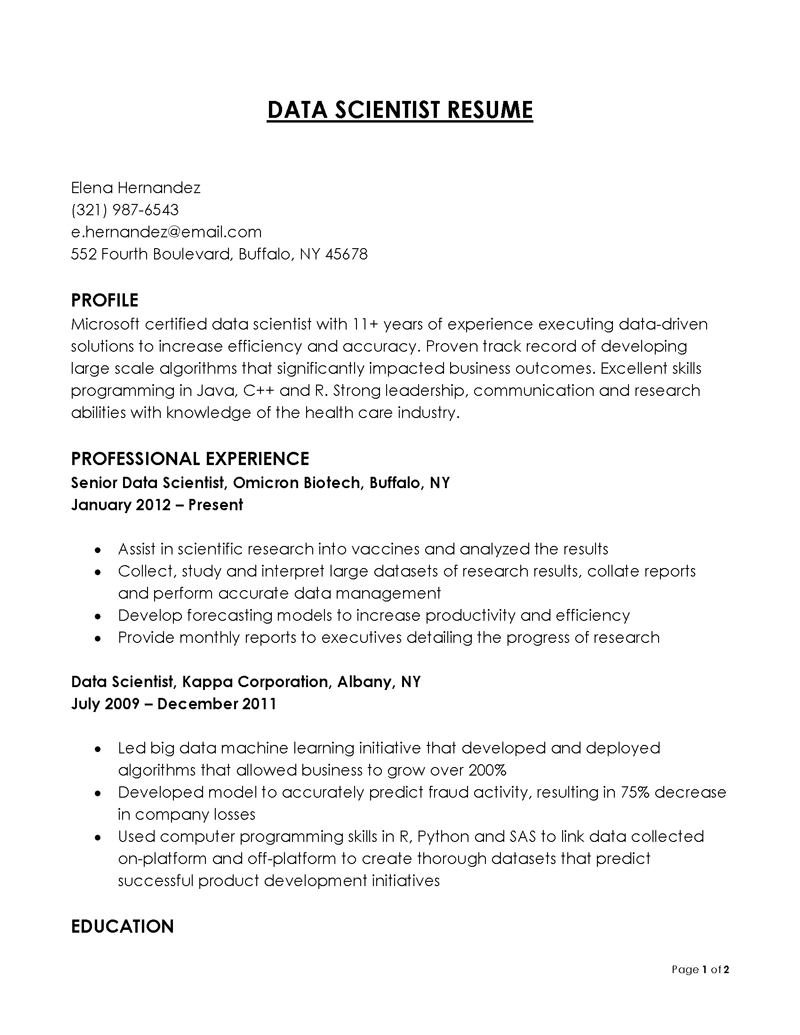
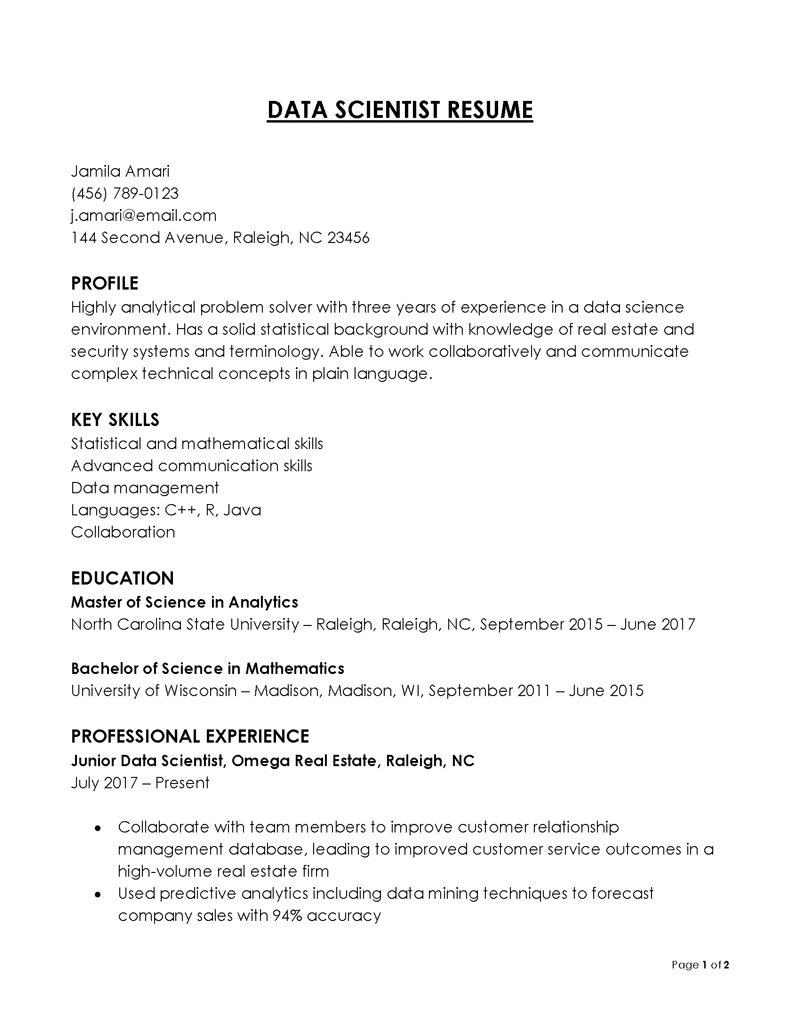
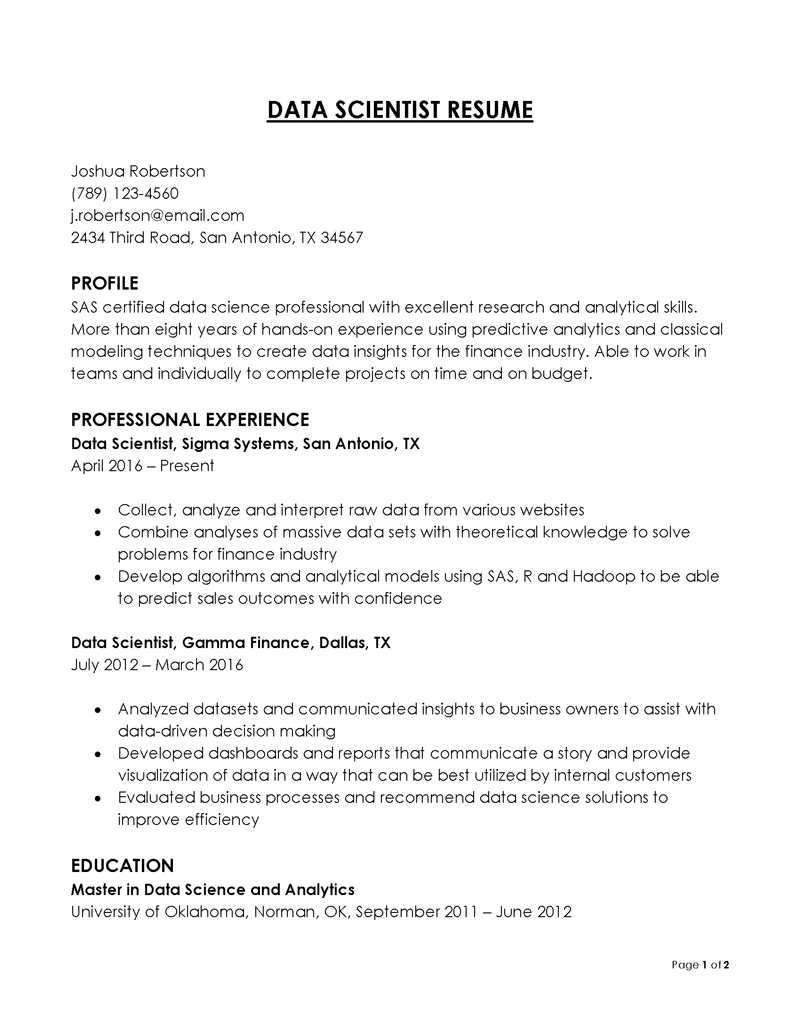
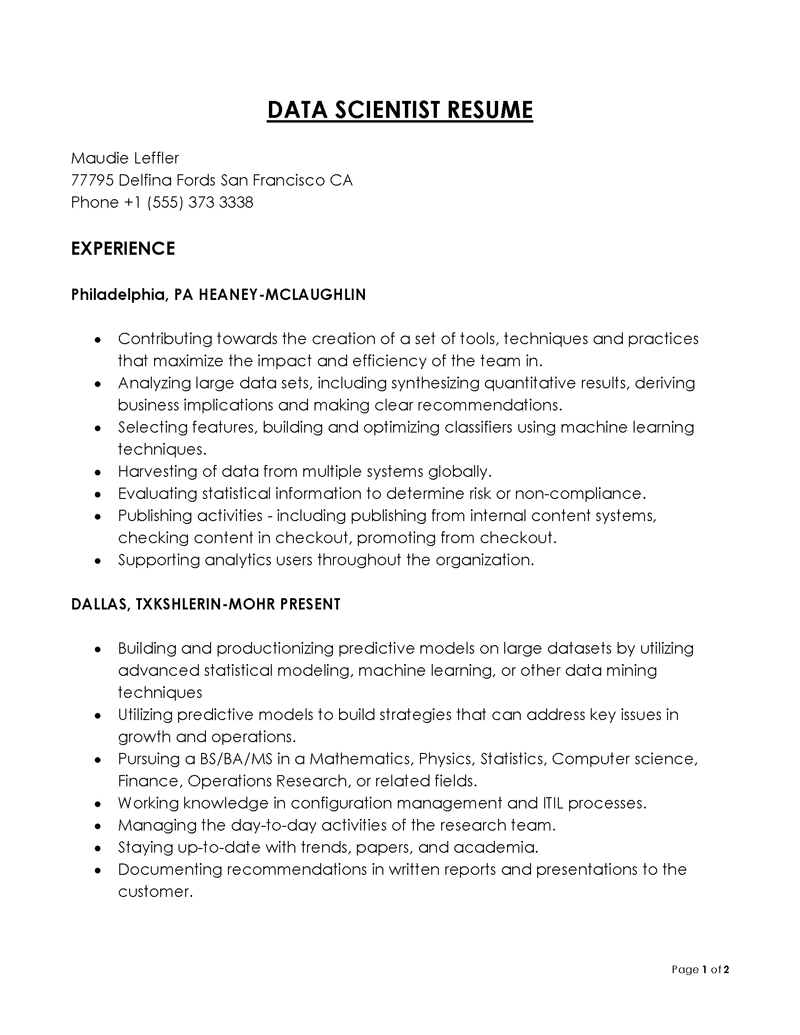
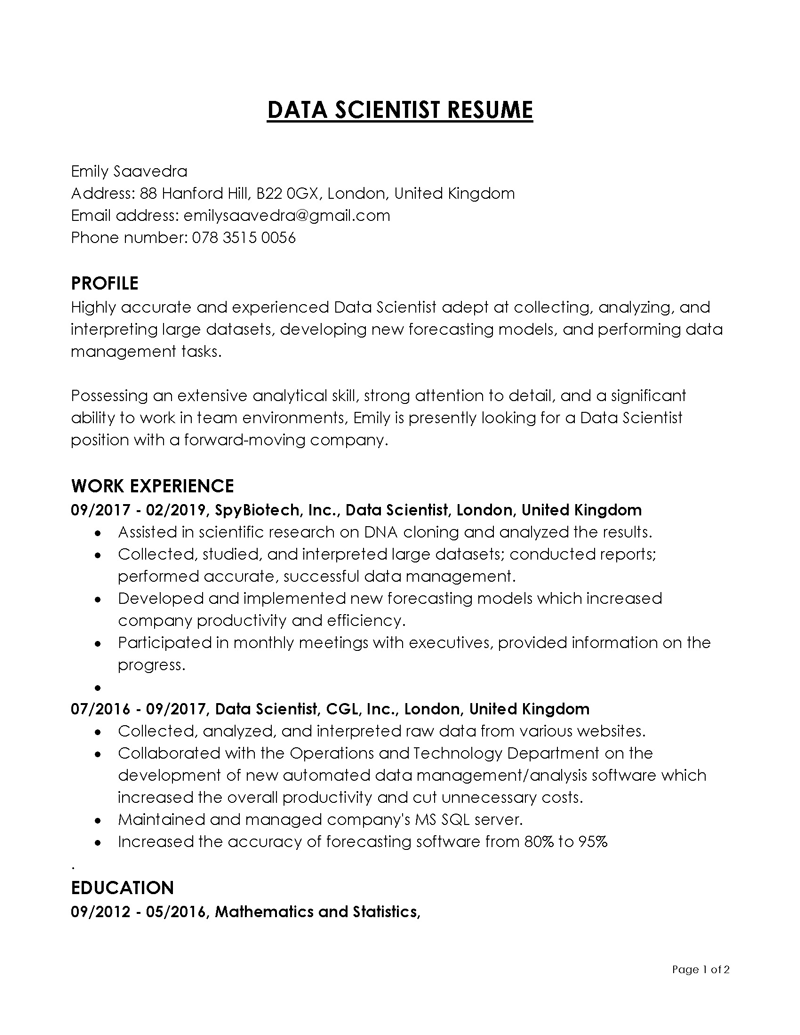
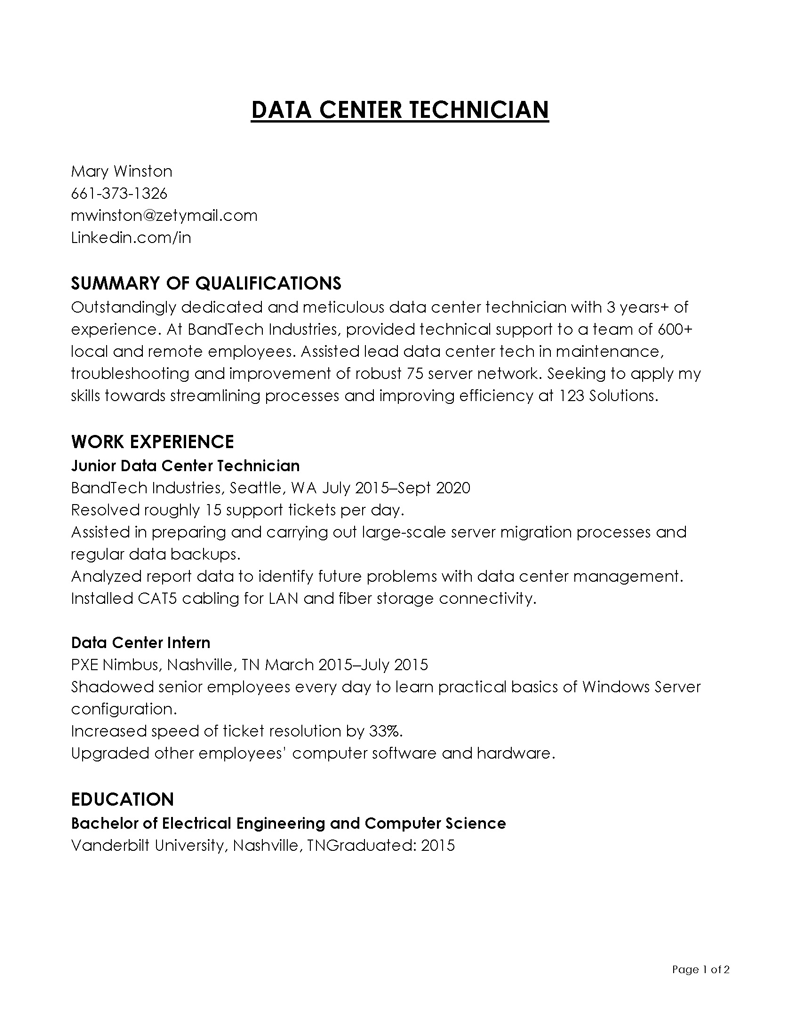
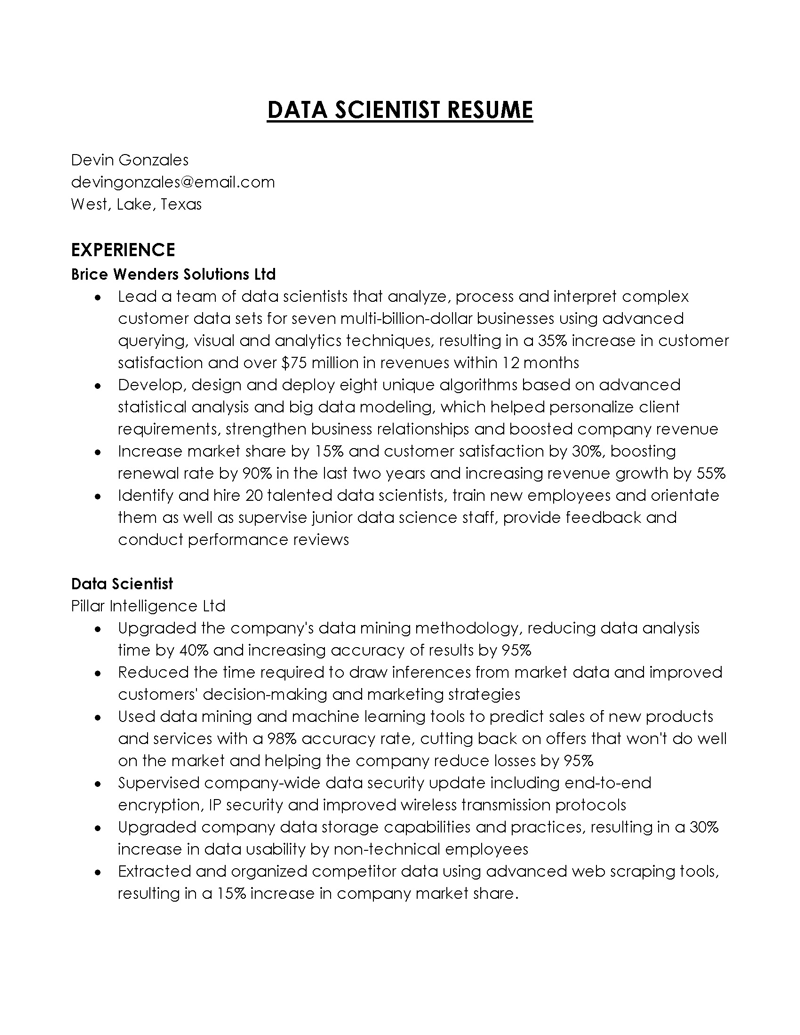
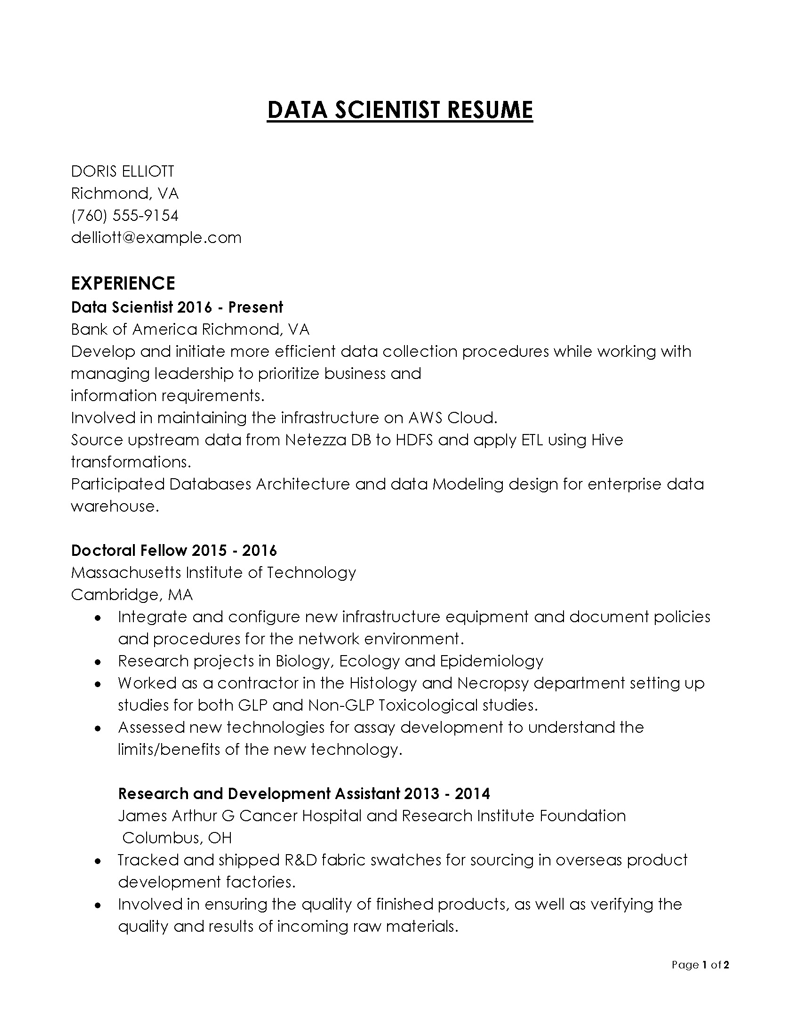
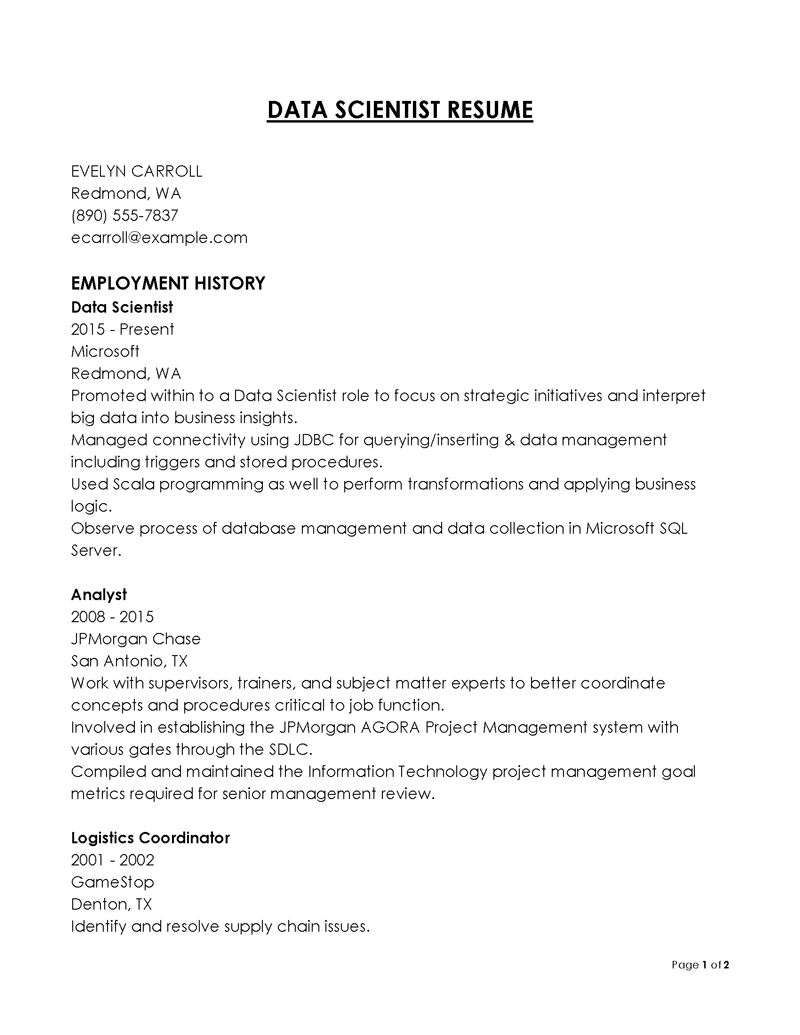
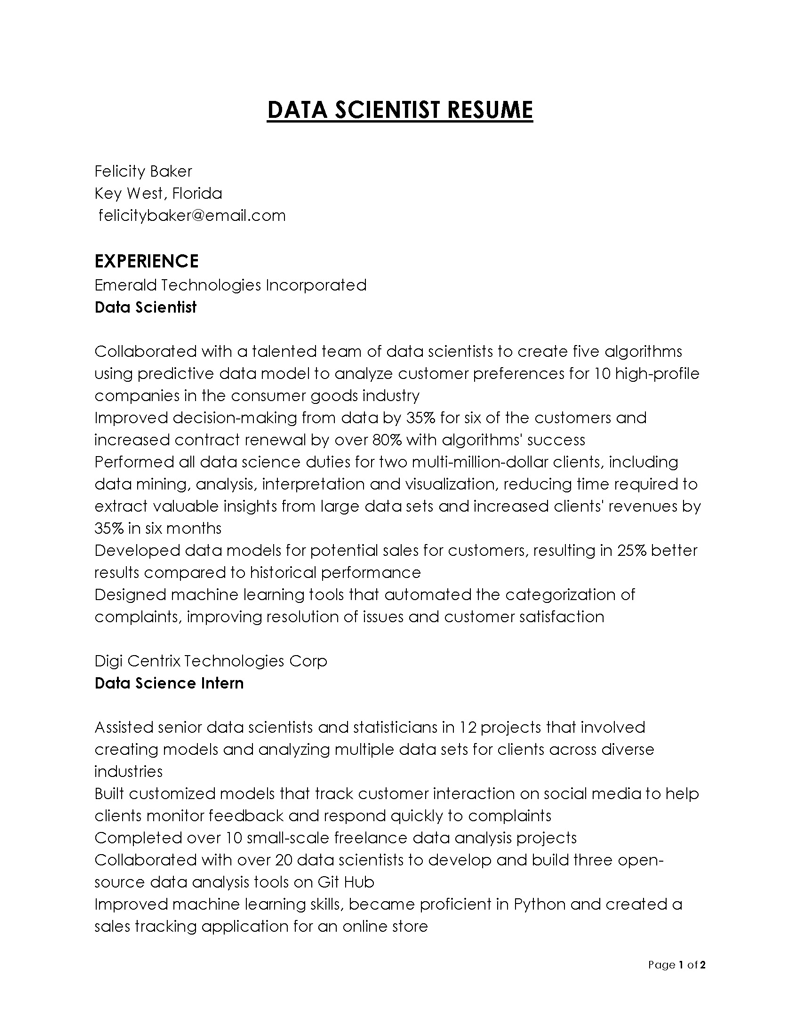
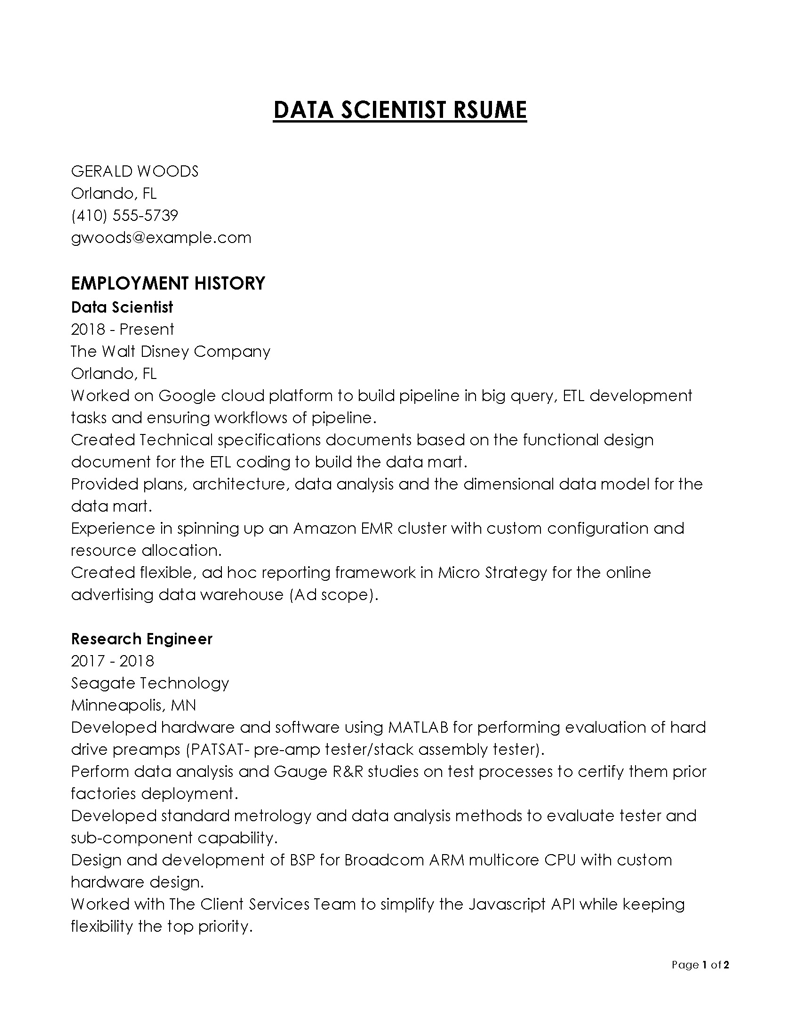

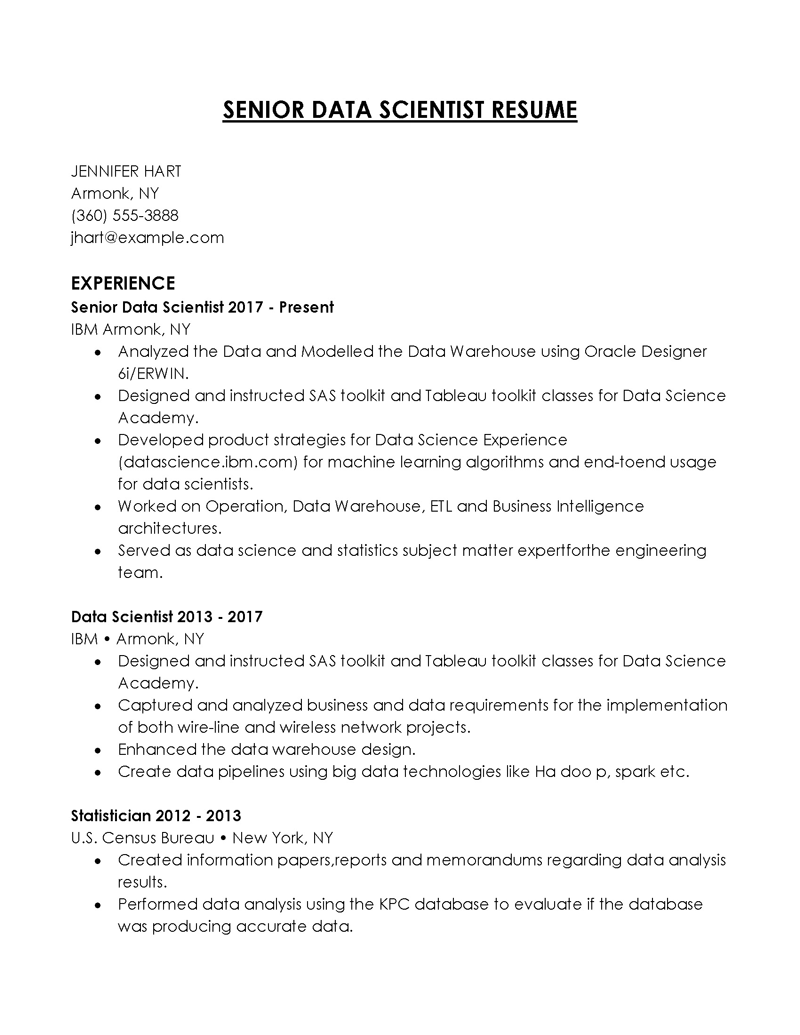
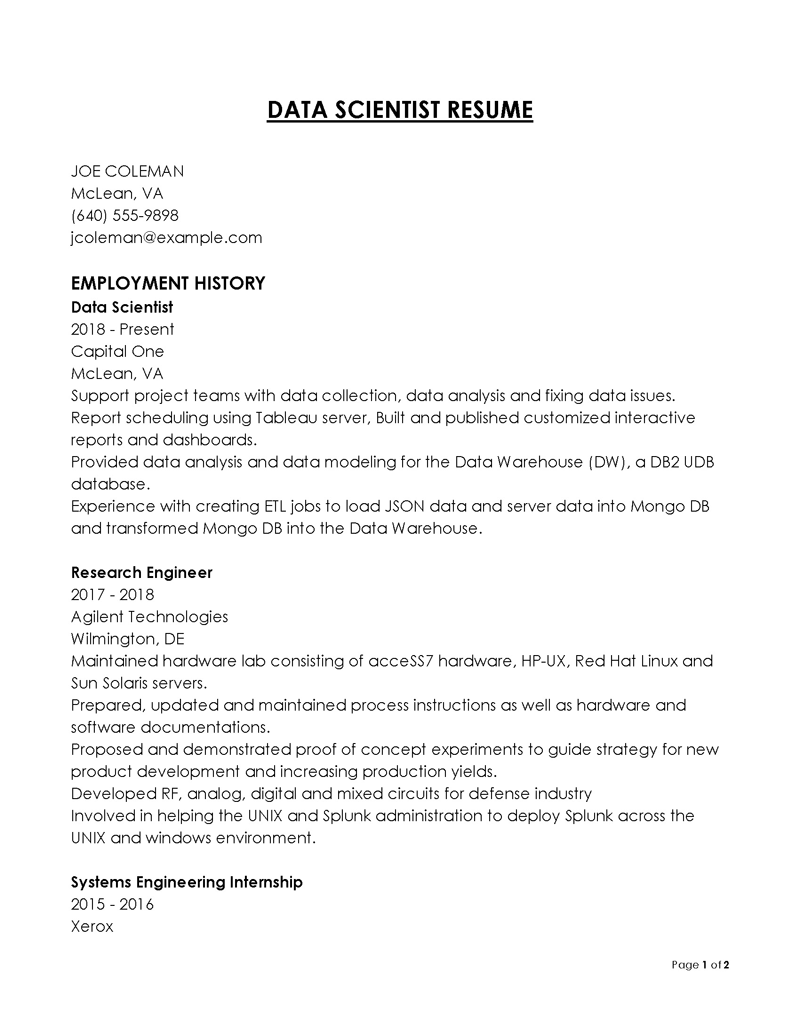
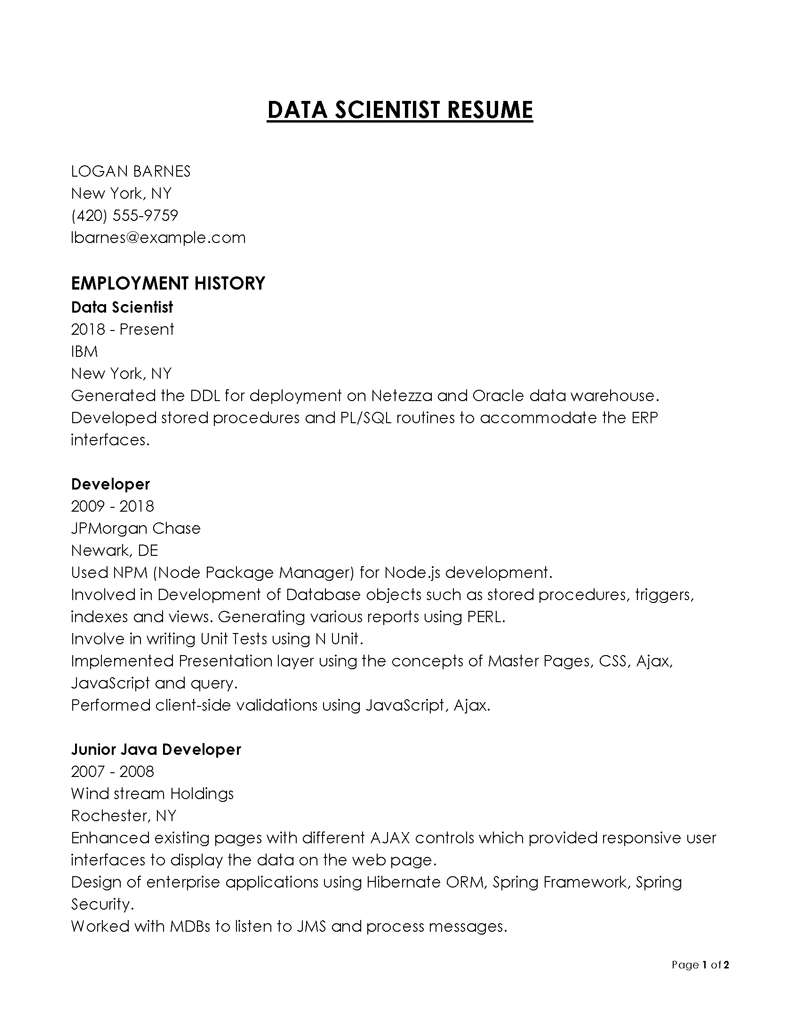
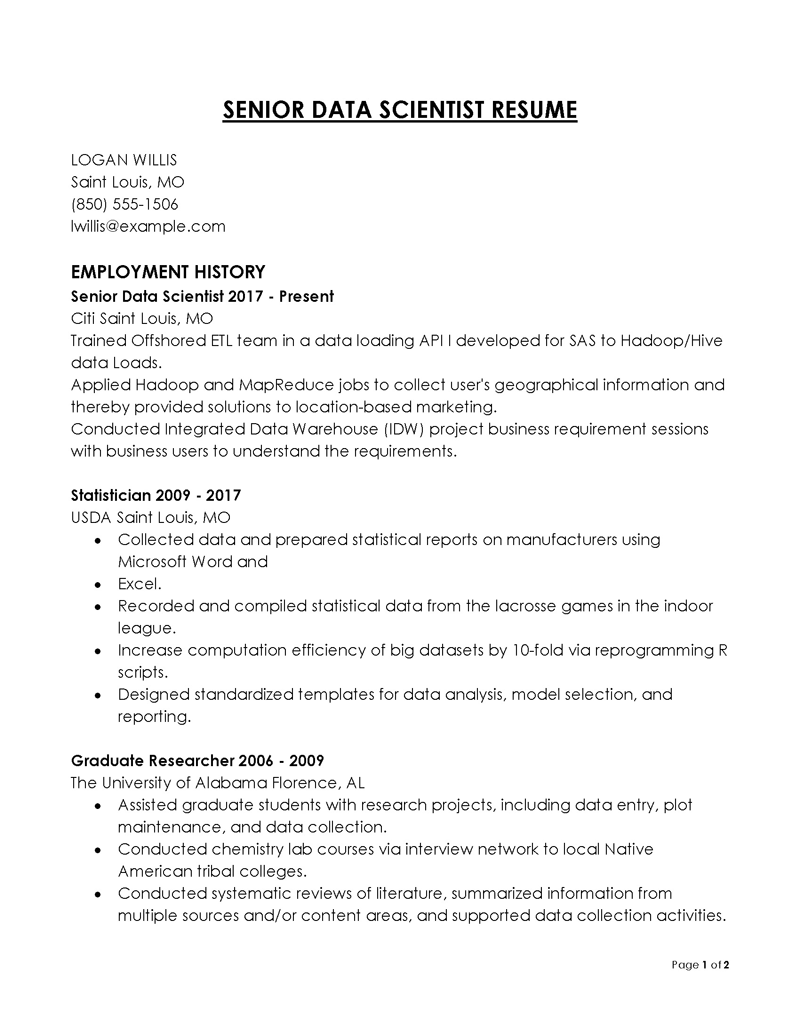


Best Practices for an Effective Resume
To master writing an outstanding resume, keep the following tips in mind:
Keep it brief
The best resumes are only one or two pages long. That is because they must be concise and contain only crucial information about the candidate. Even if you have relevant experience or skill sets to discuss, save them for an interview. Your resume must contain only the most critical points.
Customize each resume to the job description
It is certainly easier to create a universal resume and send it to every employer looking for a data scientist. However, that is not a prudent strategy if your goal is to secure the ideal job opportunity. Customize each resume to a specific job description and a particular company. Adding small details will undoubtedly impress your recruiter and give you at least the slightest advantage over the competition.
Use action verbs
Action verbs represent the best way to showcase tasks, actions, and results you have completed or achieved. Try using these action verbs in your resume:
- Analyzed
- Assessed
- Collected
- Developed
- Evaluated
- Forecasted
- Researched
- Systemized
Do your research before writing
To make an impression, research the company you are applying to before writing your resume. Since all resumes look the same, you need something to attract the recipient. Carefully reading the job description, learning more about the company, reviewing its blog, browsing some of its products or services, and scouring the internet in any other way will ensure you gather more than enough information.
Choose a professional layout
A professional layout has many advantages. First, it will help recruiters find the desired information quickly and easily. Second, it will help you appear organized, serious, and professional.
To properly organize your document:
- Use headings and subheadings to mark different sections
- Highlight essential parts, such as experience, education, and skills
- Use reverse chronological order for work experience and education
- Ensure the resume is not too cramped
Follow formatting guidelines
When formatting your resume, make sure:
- It is brief and does not include overly long bullet points
- Each bullet point represents a complete thought
- Your tenses are synchronized
- There are no grammatical or typographical errors
- Your contact information is correct.
Use formal tone
Avoid using unprofessional language. Even though resumes are not as professional as they were in the past, you should not be casual in your writing. Using slang, jargon, or another form of unprofessional language is to be avoided.
Do not include personal information
Some personal information is irrelevant to your job position, so you should not mention your gender, race, sexual orientation, marital status, or other sensitive information. Even photos are unnecessary.
Frequently Asked Questions
An excellent resume is one-page long. You can add a second page if necessary, but you should never exceed that. Recruiters and hiring managers must go through many resumes, so they will immediately discard yours if it is too long.
A resume should include your personal information, a summary statement, skills, education, experience, projects, and certifications.
It is essential to customize your resume for each job application to highlight the skills and experience that match the requirements of the job.
You can make your resume stand out by tailoring it to the specific job, using keywords, quantifying your achievements, showcasing relevant projects, and highlighting your unique skills and experiences.
If you have limited work experience in the data science field, you can highlight your relevant skills and education, include any relevant projects, and consider gaining additional experience through internships or volunteering.








